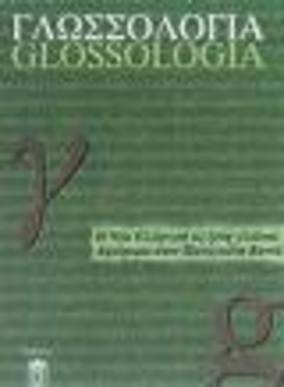Επιχειρηματολογικές πρακτικές πολυτροπικών κειμένων : Δεξιότητες αποκωδικοποίησης και ερμηνευτικές προσπάθειες έφηβων μαθητών
Part of : Γλωσσολογία ; Vol.24, 2016, pages 45-60
Issue:
Pages:
45-60
Abstract:
Modern texts are made by means of a mixture of different semiotic modes introducing in this way new organization patterns of information, new communication practices and reading paths. This seems to be more interesting in the case of print advertisements, where the semiotic modes - combined under the argumentative scope - aim at the persuasion of potential readers. The current paper, having presented how meaning is interwoven in contemporary multimodal texts facilitating new reading paths and organization patterns aims to discuss whether students completing Greek secondary education are capable of understanding persuasion strategies used in multimodal texts.
Subject:
Subject (LC):
Keywords:
επιχειρηματολογία, κατανόηση κειμένων, Λύκειο, πολυτροπικότητα
References (1):
- Albers, P. & Murphy, S. 2000. Telling Pieces: Art as Literacy in Middle School Classes. Mahwah, NJ: Lawrence Erlbaum.Baldry, A. & Thibault, P. 2006. Multimodal Transcription and Text Analysis. London: Equinox.Berninger, V., Whitaker, D., Feng, Y., Swanson, H. L. & Abbott, R. D. 1996. Assessment of planning, translating, and revising in junior high writers. Journal of School Psychology 34, 23-52.Bezemer, J. & Kress, G. 2008. Writing in multimodal texts. A social semiotic account of designs for learning. Written Communication 25 (2), 166-195.Birdsell, D. S. & Groarke, L. 1996. Toward a theory of visual argument. Argumentation and Advocacy 33 (1), 1-10.Blair, J. A. 2004. The rhetoric of visual arguments. In C. A. Hill & M. Helmers (eds), Defining Visual Rhetorics. Mahwah, NJ: Lawrence Erlbaum, 41-62.Cheong, Y. Y. 2004. The construal of ideational meaning in print advertisements. In K. L. O’Halloran (ed.), Multimodal Discourse Analysis, Systemic Functional Perspectives. London: Continuum, 163-195Davies, J. 2006. Affinities and beyond! Developing ways of seeing in online spaces. E-Learning 3 (2), 217-234.Eco, U. 1990. The Limits of Interpretation. Bloomington: Indiana University Press.Engelhard, G. Jr., Walker, E. V. S., Gordon, B. & Gabrielson, S. 1994. Writing tasks and gender: Influences on writing quality of black and white students. Journal of Educational Research 87, 197-209.Fiske, J. 1992. Εισαγωγή στην επικοινωνία (Μτφρ. Β. Μεσσήνη & Ε. Λουντζή). Αθήνα: Επικοινωνία και Κουλτούρα.Hagan, S. M. 2007. Visual/verbal collaboration in print: Complementary differences, necessary ties, and an untapped rhetorical opportunity. Written Communication 24 (1), 49-83.Halliday, M. A. K. 1989. Part A. In M. A. K. Halliday & R. Hasan, Language, Context, Text: Aspects of Language in a Social Semiotic. Oxford: Oxford University Press, 1-49.Horn, R. 1999. Information design: Emergence of a new profession. In R. Jacobson (ed.), Information Design. Cambridge, MA: The MIT Press, 15-33.Iedema, R. 2003. Multimodality, resemiotization: Extending the analysis of discourse as multisemiotic practice. Visual Communication 2 (1), 29-57.Jewitt, C. 2005. Multimodality, “reading,” and “writing” for the 21st century. Discourse: Studies in the Cultural Politics of Education 26 (3), 315-331.Jewitt, C. & Oyama, R. 2002. Visual meaning: A social semiotic approach. In T. van Leeuwen & C. Jewitt (eds), Handbook of Visual Analysis. London: Sage, 134-156.Karagevrekis, M. 2012. Multimodal text analysis of three Modern Greek printed advertisements employing the persuasive modes of ethos, logos and pathos. In W. L. Bowcher (ed.), Multimodal Texts from Around the World. Cultural and Linguistic insights. London: Palgrave MacMillan, 69-96.Knudson, R. E. 1995. Writing experiences, attitudes, and achievement of first to sixth graders. Journal of Educational Research 89, 90-97.Kress, G. 2000. Multimodality. In M. Kalantzis & B. Cope (eds), Multiliteracies: The Design of Social Future. London: Palmer Press, 164-180.Kress, G. 2010. Multimodality: A Social Semiotic Approach to Contemporary Communication. Oxon: Routledge.Kress, G. & Ogborn, J. 1998. Modes of Representation and Local Epistemologies: The Presentation of Science in Education. Subjectivity in the School Curriculum. London: University of London.Kress, G. & van Leeuwen, T. 1996. Reading Images. The Grammar of Visual Design. New York: Routledge.Kress, G. & van Leeuwen, T. 1998. Front pages: (The critical) analysis of newspaper layout. In A. Bell & P. Garret (eds), Approaches to Media Discourse. Oxford: Blackwell, 186-219.Kress, G. & van Leeuwen, T. 2001. Multimodal Discourse: The Modes and Media of Contemporary Communication Discourse. London: Arnold.Kress, G. & van Leeuwen, T. 2006. Reading Images: The Grammar of Visual Design. 2nd Edition. London: Routledge.Leiss, W., Kline, S. & Jhally, S. 1986. Social Communication in Advertising: Persons, Products, and Images of Well-Being. New York: Methuen.Lemke, J. L. 2000. Opening up closure: Semiotics across scales. In J. Chandler & G. van de Vijver (eds), Closure: Emergent Organizations and their Dynamics. New York: New York Academy of Science Press, 100-111.Marttunen, M., Laurinen, L., Litosseliti, L. & Lund, K. 2005. Argumentation skills as prerequisites for collaborative learning among Finnish, French and English secondary school students. Educational Research and Evaluation 11 (4), 365-384.Meyers, G. 1994. Words in Ads. London: Edward Arnold.O’ Halloran, K. L. 2008. Systemic functional-multimodal discourse analysis (SF-MDA): Constructing ideational meaning using language and visual imagery. Visual Communication 7 (4), 443-475.Olson, D. R. 1994. The World on Paper: The Conceptual and Cognitive Implications of Writing and Reading. Cambridge: Cambridge University Press.




